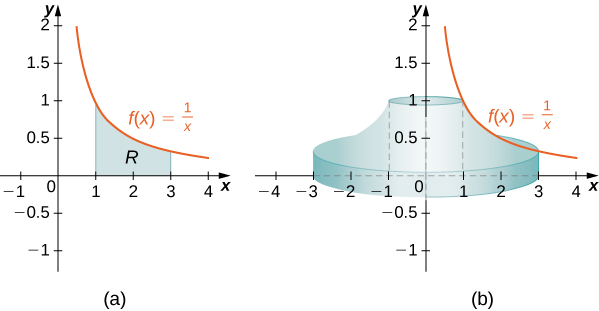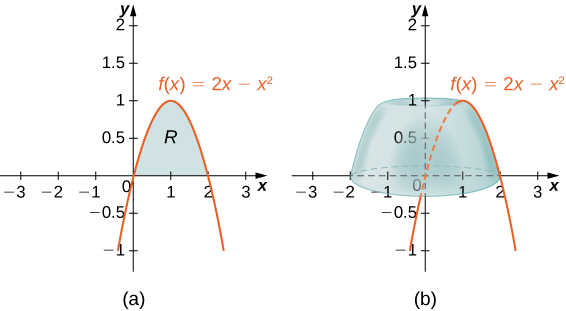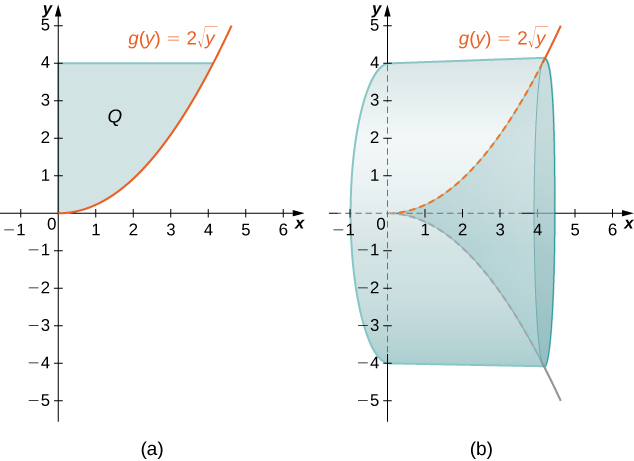Learning Outcomes
- Calculate the volume of a solid of revolution by using the method of cylindrical shells
Again, we are working with a solid of revolution. As before, we define a region [latex]R,[/latex] bounded above by the graph of a function [latex]y=f(x),[/latex] below by the [latex]x\text{-axis,}[/latex] and on the left and right by the lines [latex]x=a[/latex] and [latex]x=b,[/latex] respectively, as shown in Figure 1(a). We then revolve this region around the [latex]y[/latex]-axis, as shown in Figure 1(b). Note that this is different from what we have done before. Previously, regions defined in terms of functions of [latex]x[/latex] were revolved around the [latex]x\text{-axis}[/latex] or a line parallel to it.

Figure 1. (a) A region bounded by the graph of a function of [latex]x.[/latex] (b) The solid of revolution formed when the region is revolved around the [latex]y\text{-axis}\text{.}[/latex]
As we have done many times before, partition the interval [latex]\left[a,b\right][/latex] using a regular partition, [latex]P=\left\{{x}_{0},{x}_{1}\text{,…},{x}_{n}\right\}[/latex] and, for [latex]i=1,2\text{,…},n,[/latex] choose a point [latex]{x}_{i}^{*}\in \left[{x}_{i-1},{x}_{i}\right].[/latex] Then, construct a rectangle over the interval [latex]\left[{x}_{i-1},{x}_{i}\right][/latex] of height [latex]f({x}_{i}^{*})[/latex] and width [latex]\text{Δ}x.[/latex] A representative rectangle is shown in Figure 2(a). When that rectangle is revolved around the [latex]y[/latex]-axis, instead of a disk or a washer, we get a cylindrical shell, as shown in the following figure.

Figure 2. (a) A representative rectangle. (b) When this rectangle is revolved around the [latex]y\text{-axis},[/latex] the result is a cylindrical shell. (c) When we put all the shells together, we get an approximation of the original solid.
To calculate the volume of this shell, consider Figure 3.

Figure 3. Calculating the volume of the shell.
Notice that the rectangle we are using is parallel to the axis of revolution (y axis), not perpendicular like the disk and washer method. This could be very useful, particularly for [latex]y[/latex]-axis revolutions.
The shell is a cylinder, so its volume is the cross-sectional area multiplied by the height of the cylinder. The cross-sections are annuli (ring-shaped regions—essentially, circles with a hole in the center), with outer radius [latex]{x}_{i}[/latex] and inner radius [latex]{x}_{i-1}.[/latex] Thus, the cross-sectional area is [latex]\pi {x}_{i}^{2}-\pi {x}_{i-1}^{2}.[/latex] The height of the cylinder is [latex]f({x}_{i}^{*}).[/latex] Then the volume of the shell is
Note that [latex]{x}_{i}-{x}_{i-1}=\text{Δ}x,[/latex] so we have
Furthermore, [latex]\frac{{x}_{i}+{x}_{i-1}}{2}[/latex] is both the midpoint of the interval [latex]\left[{x}_{i-1},{x}_{i}\right][/latex] and the average radius of the shell, and we can approximate this by [latex]{x}_{i}^{*}.[/latex] We then have
Another way to think of this is to think of making a vertical cut in the shell and then opening it up to form a flat plate (Figure 4).

Figure 4. (a) Make a vertical cut in a representative shell. (b) Open the shell up to form a flat plate.
In reality, the outer radius of the shell is greater than the inner radius, and hence the back edge of the plate would be slightly longer than the front edge of the plate. However, we can approximate the flattened shell by a flat plate of height [latex]f({x}_{i}^{*}),[/latex] width [latex]2\pi {x}_{i}^{*},[/latex] and thickness [latex]\text{Δ}x[/latex] (Figure 4). The volume of the shell, then, is approximately the volume of the flat plate. Multiplying the height, width, and depth of the plate, we get
which is the same formula we had before.
To calculate the volume of the entire solid, we then add the volumes of all the shells and obtain
Here we have another Riemann sum, this time for the function [latex]2\pi xf(x).[/latex] Taking the limit as [latex]n\to \infty[/latex] gives us
This leads to the following rule for the method of cylindrical shells.
The Method of Cylindrical Shells
Let [latex]f(x)[/latex] be continuous and nonnegative. Define [latex]R[/latex] as the region bounded above by the graph of [latex]f(x),[/latex] below by the [latex]x\text{-axis},[/latex] on the left by the line [latex]x=a,[/latex] and on the right by the line [latex]x=b.[/latex] Then the volume of the solid of revolution formed by revolving [latex]R[/latex] around the [latex]y[/latex]-axis is given by
Now let’s consider an example.
Example: The Method of Cylindrical Shells 1
Define [latex]R[/latex] as the region bounded above by the graph of [latex]f(x)=1\text{/}x[/latex] and below by the [latex]x\text{-axis}[/latex] over the interval [latex]\left[1,3\right].[/latex] Find the volume of the solid of revolution formed by revolving [latex]R[/latex] around the [latex]y\text{-axis}.[/latex]
Try It
Define [latex]R[/latex] as the region bounded above by the graph of [latex]f(x)={x}^{2}[/latex] and below by the [latex]x[/latex]-axis over the interval [latex]\left[1,2\right].[/latex] Find the volume of the solid of revolution formed by revolving [latex]R[/latex] around the [latex]y\text{-axis}.[/latex]
example: The Method of Cylindrical Shells 2
Define [latex]R[/latex] as the region bounded above by the graph of [latex]f(x)=2x-{x}^{2}[/latex] and below by the [latex]x\text{-axis}[/latex] over the interval [latex]\left[0,2\right].[/latex] Find the volume of the solid of revolution formed by revolving [latex]R[/latex] around the [latex]y\text{-axis}.[/latex]
Try It
Define [latex]R[/latex] as the region bounded above by the graph of [latex]f(x)=3x-{x}^{2}[/latex] and below by the [latex]x\text{-axis}[/latex] over the interval [latex]\left[0,2\right].[/latex] Find the volume of the solid of revolution formed by revolving [latex]R[/latex] around the [latex]y\text{-axis}.[/latex]
As with the disk method and the washer method, we can use the method of cylindrical shells with solids of revolution, revolved around the [latex]x\text{-axis},[/latex] when we want to integrate with respect to [latex]y.[/latex] The analogous rule for this type of solid is given here.
The Method of Cylindrical Shells for Solids of Revolution around the [latex]x[/latex]-axis
Let [latex]g(y)[/latex] be continuous and nonnegative. Define [latex]Q[/latex] as the region bounded on the right by the graph of [latex]g(y),[/latex] on the left by the [latex]y\text{-axis},[/latex] below by the line [latex]y=c,[/latex] and above by the line [latex]y=d.[/latex] Then, the volume of the solid of revolution formed by revolving [latex]Q[/latex] around the [latex]x\text{-axis}[/latex] is given by
example: The Method of Cylindrical Shells for a Solid Revolved around the [latex]x[/latex]-axis
Define [latex]Q[/latex] as the region bounded on the right by the graph of [latex]g(y)=2\sqrt{y}[/latex] and on the left by the [latex]y\text{-axis}[/latex] for [latex]y\in \left[0,4\right].[/latex] Find the volume of the solid of revolution formed by revolving [latex]Q[/latex] around the [latex]x[/latex]-axis.
Try It
Define [latex]Q[/latex] as the region bounded on the right by the graph of [latex]g(y)=3\text{/}y[/latex] and on the left by the [latex]y\text{-axis}[/latex] for [latex]y\in \left[1,3\right].[/latex] Find the volume of the solid of revolution formed by revolving [latex]Q[/latex] around the [latex]x\text{-axis}.[/latex]
Watch the following video to see the worked solution to the above Try It.
For the next example, we look at a solid of revolution for which the graph of a function is revolved around a line other than one of the two coordinate axes. To set this up, we need to revisit the development of the method of cylindrical shells. Recall that we found the volume of one of the shells to be given by
This was based on a shell with an outer radius of [latex]{x}_{i}[/latex] and an inner radius of [latex]{x}_{i-1}.[/latex] If, however, we rotate the region around a line other than the [latex]y\text{-axis},[/latex] we have a different outer and inner radius. Suppose, for example, that we rotate the region around the line [latex]x=\text{−}k,[/latex] where [latex]k[/latex] is some positive constant. Then, the outer radius of the shell is [latex]{x}_{i}+k[/latex] and the inner radius of the shell is [latex]{x}_{i-1}+k.[/latex] Substituting these terms into the expression for volume, we see that when a plane region is rotated around the line [latex]x=\text{−}k,[/latex] the volume of a shell is given by
As before, we notice that [latex]\frac{{x}_{i}+{x}_{i-1}}{2}[/latex] is the midpoint of the interval [latex]\left[{x}_{i-1},{x}_{i}\right][/latex] and can be approximated by [latex]{x}_{i}^{*}.[/latex] Then, the approximate volume of the shell is
The remainder of the development proceeds as before, and we see that
We could also rotate the region around other horizontal or vertical lines, such as a vertical line in the right half plane. In each case, the volume formula must be adjusted accordingly. Specifically, the [latex]x\text{-term}[/latex] in the integral must be replaced with an expression representing the radius of a shell. To see how this works, consider the following example.
Example: A Region of Revolution Revolved around a Line
Define [latex]R[/latex] as the region bounded above by the graph of [latex]f(x)=x[/latex] and below by the [latex]x\text{-axis}[/latex] over the interval [latex]\left[1,2\right].[/latex] Find the volume of the solid of revolution formed by revolving [latex]R[/latex] around the line [latex]x=-1.[/latex]
Try It
Define [latex]R[/latex] as the region bounded above by the graph of [latex]f(x)={x}^{2}[/latex] and below by the [latex]x\text{-axis}[/latex] over the interval [latex]\left[0,1\right].[/latex] Find the volume of the solid of revolution formed by revolving [latex]R[/latex] around the line [latex]x=-2.[/latex]
Watch the following video to see the worked solution to the above Try It.
For our final example in this section, let’s look at the volume of a solid of revolution for which the region of revolution is bounded by the graphs of two functions.
Example: A Region of Revolution Bounded by the Graphs of Two Functions
Define [latex]R[/latex] as the region bounded above by the graph of the function [latex]f(x)=\sqrt{x}[/latex] and below by the graph of the function [latex]g(x)=\frac{1}{x}[/latex] over the interval [latex]\left[1,4\right].[/latex] Find the volume of the solid of revolution generated by revolving [latex]R[/latex] around the [latex]y\text{-axis}.[/latex]
Try It
Define [latex]R[/latex] as the region bounded above by the graph of [latex]f(x)=x[/latex] and below by the graph of [latex]g(x)={x}^{2}[/latex] over the interval [latex]\left[0,1\right].[/latex] Find the volume of the solid of revolution formed by revolving [latex]R[/latex] around the [latex]y\text{-axis}.[/latex]
Try It
Candela Citations
- 2.3 Volumes of Revolution: Cylindrical Shells. Authored by: Ryan Melton. License: CC BY: Attribution
- Calculus Volume 2. Authored by: Gilbert Strang, Edwin (Jed) Herman. Provided by: OpenStax. Located at: https://openstax.org/books/calculus-volume-2/pages/1-introduction. License: CC BY-NC-SA: Attribution-NonCommercial-ShareAlike. License Terms: Access for free at https://openstax.org/books/calculus-volume-2/pages/1-introduction





